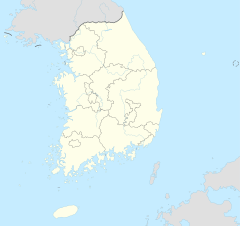Seonunsa
| Seonunsa | |
|---|---|
| 선운사 | |

View of Seonunsa Temple in South Korea
|
|
| Basic information | |
| Location | 250 Seonunsa-ro Asan-myeon Gochang-gun North Jeolla Province (Korean: 전라북도 고창군 아산면 선운사로 250) |
| Geographic coordinates | 35°29′49.3″N 126°34′42.9″E / 35.497028°N 126.578583°ECoordinates: 35°29′49.3″N 126°34′42.9″E / 35.497028°N 126.578583°E |
| Affiliation | Jogye Order of Korean Buddhism |
| Country | South Korea |
Seonunsa is a head temple of the Jogye Order of Korean Buddhism. It stands on the slopes of Dosolsan in Asan-myeon, Gochang County, near the Yellow Sea coast in western Jeollabuk-do province.
Seonunsa Temple (Korean: 선운사, Chinese: 禪雲寺, Pronounced “Seo-noon-sa”) was established by Seon Master Geomdan in 577. Several stories have been passed down concerning its establishment. One legend says there used to be a large pond occupied by dragons where the temple is now located. As Ven. Geomdan was filling the pond with rocks to drive away the dragons, an eye disease spread through the village. The monk told the villagers that anyone who poured one bag of charcoal into the pond would be healed. People rushed in with bags of charcoal, and the pond was soon filled. Ven. Geomdan named the temple Seonun (禪雲; literally “Seon clouds”) to convey his vision of cultivating Seon dwelling in the clouds.
According to the Seonunsa sajeokgi (Seonunsa Temple Records), compiled by Im U-sang in 1794, King Jinheung of the Silla Dynasty came here and established Seonunsa Temple after abdicating the throne. It also says that King Jinheung established Jungae-am Hermitage for the eternal repose of Princess Jungae, and Dosol-am Hermitage (or Dosoram) for the eternal repose of Queen Consort Dosol, but these stories lack credibility. Seonunsa Temple was rebuilt in 1318 by Seon Master Hyojeong, and again in 1474 by Seon Master Haengjo. The temple was reduced to ashes during the second Japanese invasion (1597-1598). Its reconstruction was undertaken again in 1614 by Seong Seok-jo, then governor of Mujang County, and took five years.
Seonunsa Temple owns six items of state-designated heritage: a gilt-bronze seated Ksitigarbha Bodhisattva (Treasure No. 279) ; the Main Buddha Hall (Daeungjeon, Treasure No. 290); clay seated Vairocana Buddha (Treasure No. 1752); gilt-bronze seated Ksitigarbha Bodhisattva of Dosoram (Treasure No. 279), a hermitage associated with Seonunsa Temple; stone Buddha Bas-Relief of Dosoram (Treasure No. 1200) ; and the Main Buddha Hall of Chamdangam (Treasure No. 803), another associated hermitage. In addition, Seonunsa Temple oversees three designated natural monuments: the Forest of Common Camellias (Natural Monument No. 184), the Jangsasong Pine Tree (Natural Monument No. 354), and Songak Ivy (Natural Monument No. 367). The temple also possesses 19 items of tangible cultural heritage, including the stele of Vinaya Master Baekpa (Tangible Cultural Heritage of North Jeolla Province No. 122), with an inscription based on the calligraphy of the noted calligrapher Kim Jeong-hui.
...
Wikipedia

